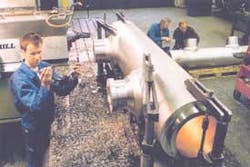Sweden: HIP manufacture extending from subsea to downhole applications
Powder metallurgical processes were recently adopted for the manufacture of six seabed manifold sections for BP Norge's Valhall Field. The 6 meter long components were installed late last year using a manufacturing process that minimizes the amount of welds in the tubing.
The manifolds were manufactured by Metso Powdermet in Surahammar, Sweden. The company is a world leader in the development of hot isostatic processing (HIP) technology. Its track record that includes the largest component ever manufactured with the HIP process, part of a floating production, storage, and offloading (FPSO) vessel swivel that was over two meters long and weighed 14 tons.
Metso Powedermet's ability to manufacture complex shapes with high metallurgical integrity has resulted in several recent orders from the offshore sector. Swivels for FPSOs have proved particularly suitable for this process - the company recently manufactured three swivels for different customers. Each weighed 3-12 tons and were delivered as 10 individual components.
Uniform structure
The company uses the world's largest hot isostatic press with an internal capacity measuring 3.5 meters long and 1.3 meters in diameter. The HIP process makes it possible to manufacture very complex shapes such as manifolds and valve bodies from high quality alloys that meet the highest standards of metallurgical integrity.
When viewed under a microscope, the finished metal product will demonstrate a uniformly fine granular structure metallurgically superior to the longer and more inconsistent grains that result from a component being forged. High alloyed duplex stainless steel in particular demonstrates a HIP'd microstructure with unifrom islands of ferrite and austenite that will prevent problems arising from hydrogen formation caused by cathodic protection in subsea installations.
The process has been refined to ensure molecular homogeneity throughout the entire structure of even the most complex workpieces. In some cases the HIP process has been found to be the only option available for designers of components using special alloys that can be neither cast nor forged.
HIP manufacturing involves the construction of a capsule out of 2 mm sheet carbon steel. This is a highly skilled task in which every detail of the work piece is shaped so that the capsule can serve as a completely air-tight mold for the finished item. The capsule is made larger than the finished product to allow for shrinkage, and by carefully controlling the size of the finished component it is possible to minimize the amount of machining required afterwards.
The nature of the Metso Powdermet process makes it possible to manufacture components in any type of metal. These are supplied to the factory as a high grade powder with uniform spherical size. The capsule is filled with the powder after which the air is evacuated and the component is sealed. Once in the HIP the capsule is subjected to temperatures ranging from 1,130-1,180° C in an atmosphere of argon gas and nitrogen which is used to create the extreme pressures needed in a carefully controlled process. The work piece is likely to be in the HIP for up to 12 hours and on removal it is subjected to an etching process that removes the carbon steel capsule and leaves the component ready for final finishing as required.
Inconel cladding
Another benefit of the Powdermet process is its ability to produce components from composites of different metals. This enables the designer to address the problem of differing levels of erosion and corrosion resistance that may be required in the same component. For recent orders, the company has developed this capability to provide cladding inside forged valve bodies. The HIP process is used to provide corrosion resistance by applying a layer of Inconel onto the forged carbon steel body, which is then machine finished. The risk of micro cracks is eliminated with the HIP process.
A new group of Metal Matrix Composites (MMC) has recently been developed by Metso Powdermet. Through inclusion of varying ratios of carbide within the mixture, it is now possible to clad a component with a wear-resistant coating of any thickness. This would typically involve the carbides being combined with Duplex or Super Duplex to create a matrix capable of resisting both corrosion and erosion, and may now be considered the optimum solution for sand separators and components exposed to drilling mud and cuttings.
For more information contact Göte Björman, Metso. Tel: +46 220 348 80, Fax: +46 220 334 90, Email: [email protected]


